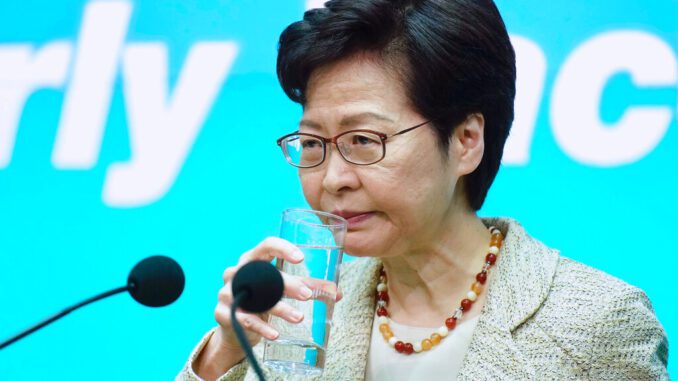
HONG KONG — China’s government said Tuesday no abnormal radiation was detected outside a nuclear power plant near Hong Kong following a news report of a leak, while Hong Kong’s leader said her administration was closely watching the facility.
The operators released few details, but nuclear experts said that based on their brief statement, gas might be leaking from fuel rods inside the reactor in Taishan, 85 miles west of Hong Kong.
In Beijing, Foreign Ministry spokesperson Zhao Lijian gave no confirmation of a leak or other details. He responded to reporters’ questions by saying, “there is nothing abnormal detected in the radiation level surrounding the plant.”
In Hong Kong, radiation levels Tuesday were normal, according to the Hong Kong Observatory.
Framatome, a French company that helps manage the Taishan Nuclear Power Plant in Guangdong province, said Monday it was dealing with a “performance issue.” It said the facility was operating within safe limits.
That followed a report by CNN that Framatome told U.S. authorities about a possible leak.
“With regards to foreign media reports about a nuclear plant in Taishan, Guangzhou, the Hong Kong government attaches a high degree of importance to this,” said Hong Kong Chief Executive Carrie Lam.
She said her government would ask authorities in Guangdong for information and tell the public about any developments.
China is one of the biggest users of nuclear power and is building more reactors at a time when few other governments have plans for new facilities because the cost of solar, wind and other alternatives is plunging.
Chinese leaders see nuclear power as a way to reduce air pollution and demand for imports of oil and gas, which they deem a security risk. Government plans call for Hong Kong to use more mainland nuclear power to allow the closure of coal-fired power plants.
The Taishan plant, which began commercial operation in December 2018, is owned by China Guangdong Nuclear Power Group and Electricite de France, the majority owner of Framatome. A second reactor began operating in September 2019.
They are the first of a new type called European Pressurized Reactors. Two more are being built in Finland and France.
CNN reported Framatome wrote to the U.S. Department of Energy warning of an “imminent radiological threat” and accusing Chinese authorities of raising acceptable limits for radiation outside the plant to avoid having to shut it down.
U.S. officials believed there was no severe safety threat, CNN said.
The Department of Energy did not immediately respond to requests for comment. The International Atomic Energy Agency, a U.N. body, told The Associated Press it was aware of the issue and was awaiting information from China.
Electricite de France said Monday it was informed of the increase in concentration of “certain noble gases” in Taishan reactor No. 1.
That suggests fuel rods are leaking gases produced during nuclear fission, according to Luk Bing-lam, an expert on nuclear engineering at the City University of Hong Kong.
Noble gases such as xenon and krypton are byproducts of fission along with particles of cesium, strontium and other radioactive elements.
“If the leakage is more severe, then you will start seeing more radioactive material like cesium, rather than gas,” said Luk, who is chairman of the Hong Kong Nuclear Society.
Such leaks “happen every so often” in China and plants “usually can handle it themselves,” Luk said. But he said this incident might be complicated if the Taishan plant uses U.S. technology that is covered by export restrictions.
China’s state-owned nuclear power companies are on Washington’s “entity list” that bars them from obtaining U.S. technology without government approval.
The French partner might ask for permission because Framatome previously licensed technology from Westinghouse, Luk said.
“With the situation now, that becomes difficult,” he said. “For even a small problem, they need U.S. government approval.”
China has 50 operable reactors and is building 18 more, according to the World Nuclear Association, an industry group. It is largely self-sufficient in reactor design and construction but is “making full use of Western technology while adapting and improving it,” the association says on its website.
China has constructed reactors based on French, U.S., Russian and Canadian technology and has developed its own Hualong One reactor, based on Westinghouse technology, marketing it abroad since 2015.
Hong Kong gets as much as one-third of its power from the Daya Bay nuclear power plant east of the territory in Guangdong.
Luk, who has worked with Chinese nuclear power plant operators, said he asked the company for information about the leak but managers won’t talk about it.
“I suspect the leakage is far more widespread than just a single assembly,” he said. “Because of that, they probably need some special technology to resolve this leakage problem.”
Previously, the Taishan facility leaked a “small amount” of radioactive gas on April 9, the National Nuclear Safety Administration said on its website. It said the event was “Level 0,” or “without safety significance.”
Zhao, the Foreign Ministry spokesperson, defended China’s nuclear safety record and said the nuclear agency works with regulators in other countries and the IAEA.
“China’s nuclear power plants have maintained a good record in operation and no incidents affecting the environment or public health have occurred,” Zhao said.



